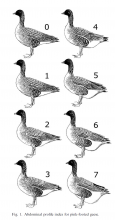Current Size: 76%
Effects of neckbands on body condition of migratory geese
Summary
Ringing and marking are widely used techniques in avian ecology to assist studies of migration, survival and behaviour, and often used to estimate population sizes. However, only rarely, are the effects of these markings on birds thoroughly tested. Using an abdominal profile index of marked geese and body mass of recaptured birds previously marked, this study investigated the effect of neckbands on body condition of Pink-footed Geese Anser brachyrhynchus to evaluate to what extent capture, handling and banding affected these birds on short, medium and longer terms
Its results indicated that body condition of geese were negatively affected in the days immediately succeeding capture, but that only a minor effect persisted on a seasonal scale. The study found no support for a long-term effect of neckbands on the body mass of individual birds and the long-term effects are expected to be minor. Nevertheless the capture and handling event might be the cause of a temporary decline in body condition. In addition, neckbands might still influence important life-history traits such as reproduction and survival by means of, e.g., altering social interactions, increasing predation or interfering with mate acquisition.
The study is described in an article published in the Journal of Ornithology and is available on-line.
A PDF copy is attached:
















